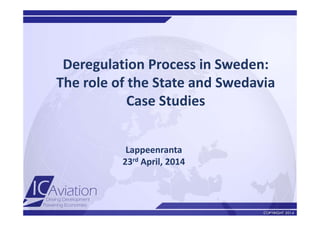Privatization process in Sweden: the role of the state and Swedavia, Olle F├żlt)
- 6. ’āś Break┬Āup┬Āof┬ĀLFV┬Āaviation┬Āmonopoly┬Āin┬Ā 2009 ’āś LFV┬Āto┬Ākeep┬Āon┬Ātechnical┬Āaspects┬Āonly┬Ā┬Ā┬Ā ’āś New┬Ācompany┬Ā(Swedavia)┬Āestablished┬Ā to┬Āmanage┬Ā/┬Ārun┬Āthe┬Āairports┬Ā ’āś Also┬Āa┬Āpolitical┬Ādecision┬Āto┬Āsell┬Āsome┬Āof┬Ā the┬ĀLFV┬Ā/┬ĀSwedavia┬Āairports┬Ā ’āś Recognition┬Āof┬Āuncompetitive┬Āand┬Ā highly┬Āexpensive┬Āmodel┬Ā┬Ā Swedish┬ĀTimeline
- 7. The┬ĀSale┬ĀProcess┬ĀŌĆō Regional┬ĀPerspective┬Ā ’āś Regions nervous about taking on airports ’āś Long term implications of ŌĆ£owningŌĆØ airport not clear ’āś Feeling that itŌĆÖs a govnt. obligation ’āś Opportunistic regions could see the benefits ’āś Very fast negotiations resulted in quick sales ’āś Already in 2006 KLR, NRK, HAD were sold SLOW FAST
- 8. 1. EXŌĆÉSWEDAVIA┬Ā ’āś Norrkoping┬Ā(2006) ’āś Halmstad┬Ā(2006)┬Ā┬Ā ’āś Kalmar┬Ā(2006)┬Ā ’āś Karlstad┬Ā(2010) ’āś J├Čnk├Čping┬Ā(2010) ’āś Skellefte├ź┬Ā(2010) ’āś ├ängelholm┬Ā(2011) ’āś ├¢rnsk├Čldsvik┬Ā(2011) ’āś Sundsvall┬Ā(2013) 2.┬ĀSWEDAVIA┬Ā ’āśStockholm┬Ā(ARN) ’āśStockholm┬Ā(BMA)┬Ā ’āśGothenburg┬Ā ’āśMalm├Č ’āśLule├ź┬Ā ’āśUme├ź┬Ā ’āś├¢stersund┬Ā ’āśVisby┬Ā ’āśRonneby┬Ā ’āśKiruna Sweden┬ĀStatus┬ĀQuo
- 9. Ownership┬ĀModels┬ĀŌĆÉ Sweden ├ängelholm ’āś 100%┬Āprivate ’āśReal┬Āestate┬Āmakes┬Āit┬Āprofitable ’āśPEAB;┬Āconstruction┬Ācompany┬Āwith┬Ādevelopment┬Āplans J├Čnk├Čping┬Ā ’āśAirport┬Āmunicipality┬Āowned┬Ā ’āśAirport┬Āreal┬Āestate┬Ācontrolled┬Āby┬Āseparate┬Āmunicip.┬Ācompany┬Ā Karlstad,┬ĀHalmstad ’āśMunicipality┬Āowned┬Ā ’āśConsidered┬Āa┬Āpublic┬ĀŌĆ£utilityŌĆØ┬Ā V├żxj├Č ’āś Infrastructure┬Āowned┬Āby┬Āthe┬Āregion┬Āand┬Ā2┬Āmunicipalities ’āśAirport┬Ātower┬Āservices┬Āin┬Āseparate┬Ācompany
- 10. ’āś Old┬Āphilosophy┬ĀŌĆō did┬Āsame┬Āthings,┬Āin┬Āthe┬Āsame┬Āway┬Ā ’āś Since┬Ā2006┬ĀŌĆō no┬Ādevelopment┬Āwhatsoever┬Ā ’āś Dependent┬Āon┬Ā2┬Ācarriers┬Ā(BRA┬Ā&┬ĀNextJet┬ĀŌĆō both┬Āflying┬Āto┬Ā Stockholm)┬Ā ’āś No┬Ādevelopment┬Āstrategy┬Āand┬Āno┬Āfuture┬Āvision┬Ā ’āś 2015┬ĀŌĆō employed┬Āwell┬Āknown┬Āconsultants!┬Ā┬Ā Staying┬ĀStillŌĆ”ŌĆ”ŌĆ”┬Ā
- 11. ’āś Took┬Ātime┬Āto┬Āadapt┬Āto┬Ānew┬Āownership┬Ā ’āś Slow┬Āpace┬Āof┬Ādevelopment,┬Ābut┬Āit┬Āwas┬Āquite┬Āplanned┬Āand┬Ā deliberate┬Ā┬Ā ’āś Recent┬Āyears┬Āhas┬Āseen┬Āchange┬ĀŌĆō in┬Āparticular┬Āthe┬Ā uncertainty┬Āaround┬ĀSASŌĆÖs┬Āfuture┬Ā┬Ā ’āś New┬Āstrategy┬Āand┬Ānow┬Ānew┬Āroutes:┬Āscheduled┬Āservice┬Āto┬Ā Berlin┬Āand┬Āincreased┬Ācharters┬Ā CautiousŌĆ”ŌĆ”ŌĆ”┬Ā
- 12. ’āś Took┬Āa┬Ādifferent┬Āapproach┬Āimmediately┬Ā ’āś Revolutionised┬Āaero┬Ā&┬ĀnonŌĆÉaero┬Ādevelopment┬Ā ’āś Several┬Ānew┬Ācarriers:┬Ālow┬Ācost┬Āand┬Āscheduled ’āś Charter┬Ābiz┬Ā+35% RevolutionŌĆ”ŌĆ”ŌĆ”┬Ā












